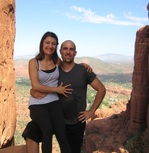Our last few posts have been focused on a combination of Zen & history as we traveled throughout Japan. There is no doubt that South Korea is full of both with its own tradition of Zen Buddhism as well as a fascinating history dating back to the era of the 3 Kingdoms and continuing through the Joseon dynasty, which was one of the most enduring monarchies in history. South Korea’s more modern history in the 20th century includes the Japanese occupation, the division of the peninsula after WWII and the ensuring war, as well as the country’s meteoric rise as an economic power would all be grist for a great post. But instead of all that we’re going to focus on something truly scrumptious – the delicious food!
Bulgogi
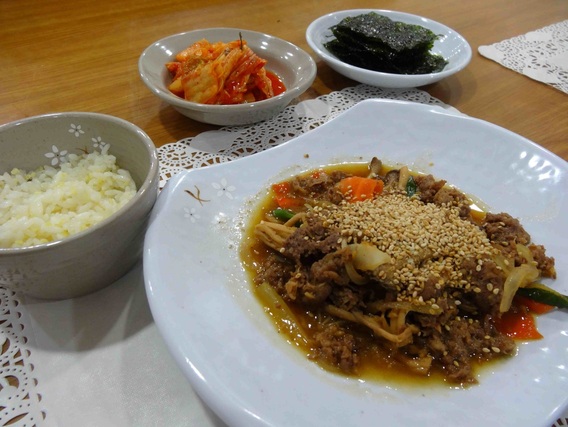
Bulgolgi we cooked at Food & Culture Korea Academy (see below)
After a short flight on the absurdly cheap Peach Airlines from Osaka to Seoul (for $30/person!), our first stop upon getting into the city was for the famous Korean BBQ. If you’ve never been to a Korean BBQ restaurant before, its unique feature is that the meats are cooked at the table in front of you with a variety of vegetables and sauces.
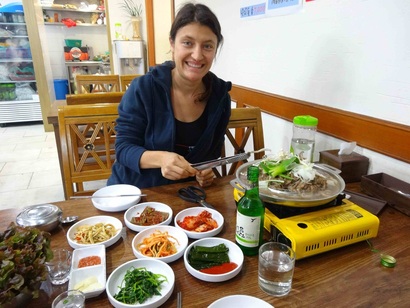 Our first bulgolgi in Korea!
Our first bulgolgi in Korea! Our first dish might have had to be the heart of Korean BBQ – Bulgogi. Bulgogi is thinly sliced sirloin that has been marinated in a sauce consisting of soy sauce, sesame oil, minced garlic, pear juice, and a bit of sugar and spice. It cooks on a grill in front of you with green onions, carrot, onion, and mushroom. The result is a melt in your mouth experience that has been with Korean people since the time of the Goguryeo kingdom (37BC-668AD). It was immensely popular until Buddhist influence spread over the peninsula and the carnivorous dish took a backseat, only to be reintroduced with a vengeance when the Confucian-focused Joseon dynasty came to power in 1392.
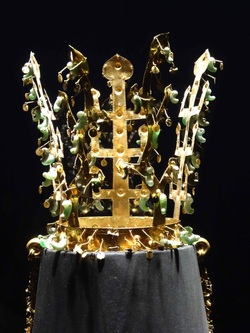
To learn a bit about Korea’s fascinating history, we headed over to the National Museum of Korea. There we saw an amazing
gold crown made for the Kings of the Silla Kingdom (who defeated the Goguryeo Kingdom above with the help of the Chinese Tang dynasty). Its complex symbolism includes tree branches symbolizing the world and horns symbolizing reindeer. It also had little embryo shaped pieces of jade attached to it that may have symbolized fertility. The most impressive piece for us was a gracefully carved bronze “Pensive Buddha” which was also from the Silla Kingdom. Here, Prince Shakyamuni sits contemplating the world with one leg crossed on top of his thigh and his hand gently holding his head. To me it is like the Eastern counterpart of Rodin’s “The Thinker”. Interestingly, the Thinker is muscle bound and hunched over while the Pensive Buddha’s posture is fairly upright and his body thin. Do the two sculptures tell us something about the differences between the cultures of the West versus the East?
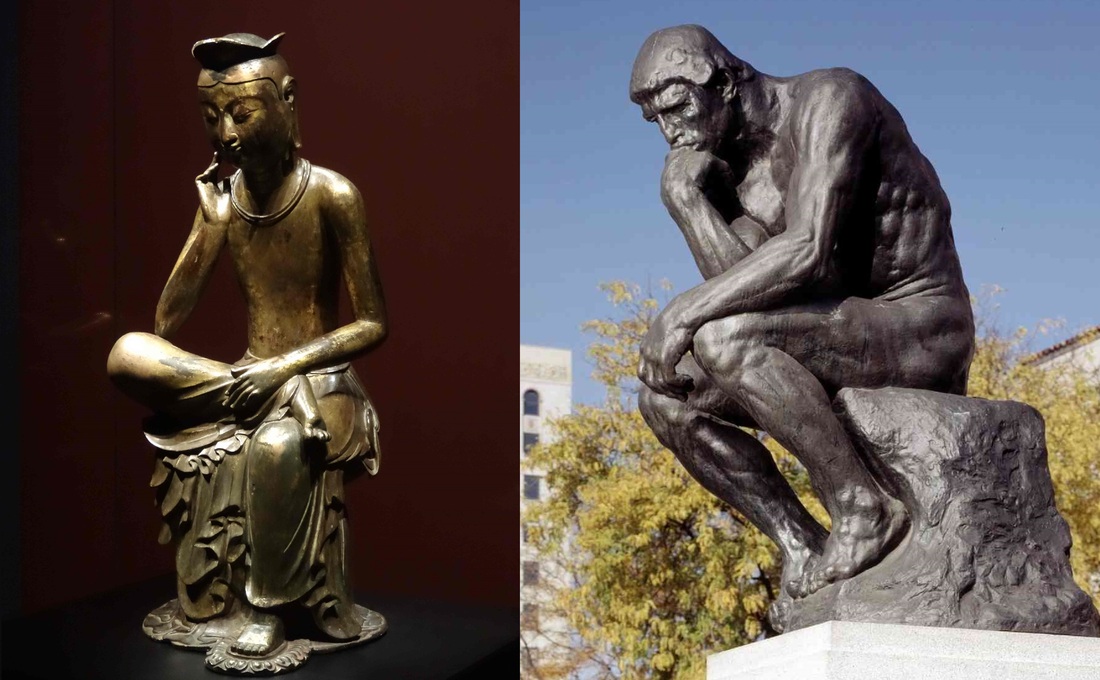
The similarities are remarkable - this is our picture of the Pensive Buddha - the Rodin pic is linked to its original source.
Juk
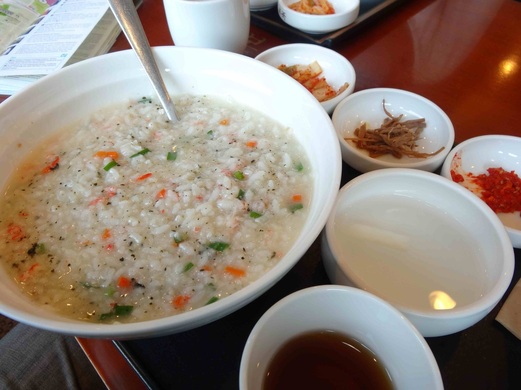
Traditional Korean juk
After the museum we headed down to Yeouido Park where we saw that our short hop on the plane had taken us right back into Cherry Blossom season! The Koreans weren’t quite as enthusiastic as the Japanese with their
Hanami parties, but everyone was still enjoying the delicate blooms blowing in the wind along with the flavors of festival food.
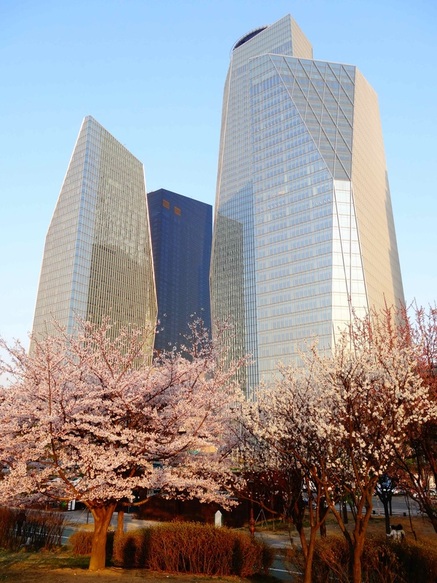
Cherry Blossoms at Yeouido Park during sunset
The next morning we tried out Korean rice-porridge, known as “juk”. This dish is pan-asian as rice is a common staple across the region, having been introduced by China thousands of years ago. Neda tried the beef and mushroom variety and I had crab and spring onion. While our expectations were high, we have to give the nod to the
Thai version of the dish, which was much more flavorful owing to its high use of ginger, garlic, cilantro and spicy pepper!
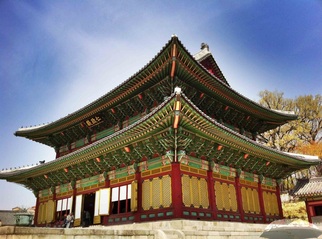 Changdeokgung Palace Throne Hall
Changdeokgung Palace Throne Hall After our juk, we headed to Changdeokgung Palace where we were treated to two interesting guided tours of the grounds. First we saw the palace itself, which was constructed in 1405 as a secondary palace of the Joseon Dynasty. It burned during Japanese invasion in 1592, but was rebuilt in 1610. The throne room, King’s bedchamber, and other structures of the palace feature sweeping roofs and the forest-green and maroon color scheme of the royal family. Behind the palace lies a 78 acre “rear garden” with 300 year old trees and lotus ponds overlooking libraries and buildings the royalty used to host guests or just simply to write poetry or watch the moon. Pretty nice life!
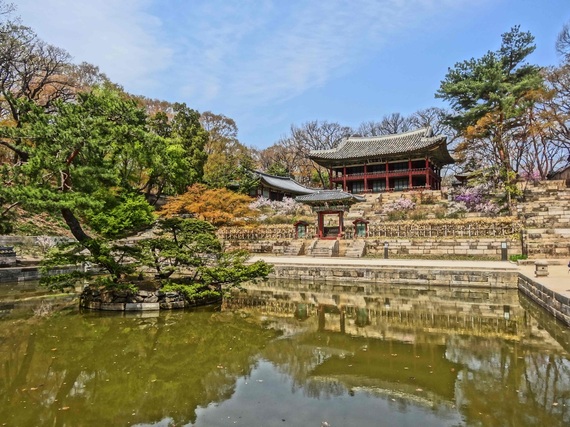
Library at the rear garden
Kimchi
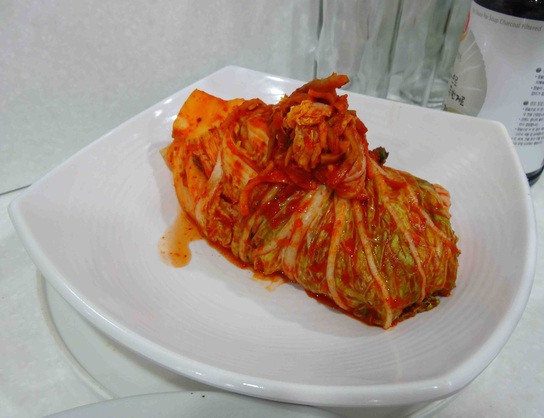
Our homemade Kimchi!
The next day we decided to go a little deeper into Korean cuisine. We booked a class at the
Food & Culture Korea Academy to learn how to make some of our favorites: Bulgolgi & Kimchi. To those of you familiar with Korean Cuisine, it might seem strange I didn’t mention it off the bat. The spicy fermented cabbage dish is a staple of the Korean diet, appearing as a side dish at practically every meal that we ate while in Seoul. In fact, one of the charming aspects about dining in Korea is the plethora of small sides that accompany every meal – from a simple breakfast to an elaborate dinner. You always have some kimchi, maybe some bean sprouts, tofu in spicy sauce, marinated beans, etc…
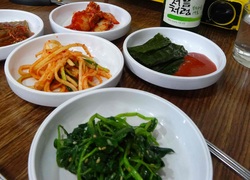 variety of kimchi
variety of kimchi Kimchi is the show-stopper however. It doesn’t have to be cabbage, as there are hundreds of versions made with cucumbers, radishes, and other veggies. In fact, though the napa cabbage is the most ubiquitous type of kimchi, it wasn’t the first type made because the Chinese had yet to introduce the cabbage in the earliest years of production. Over 2,000 years ago, kimchi was produced for two major reasons:
conservation and digestion.
The cold winters in Korea and mountainous topography made whatever veggies that grew quite precious. So the Koreans salted them to keep them edible during the long cold winters. Additionally, rice wasn’t introduced to the peninsula until later by the Chinese. This meant early Koreans were eating mainly tough grains like barley and millet. The probiotic bacteria in kimchi helped people to extract the nutrients from the grains and also boosted their immunity.
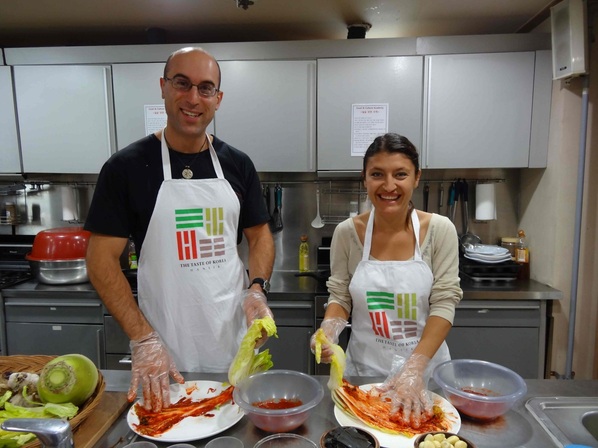
Making our Kimchi!
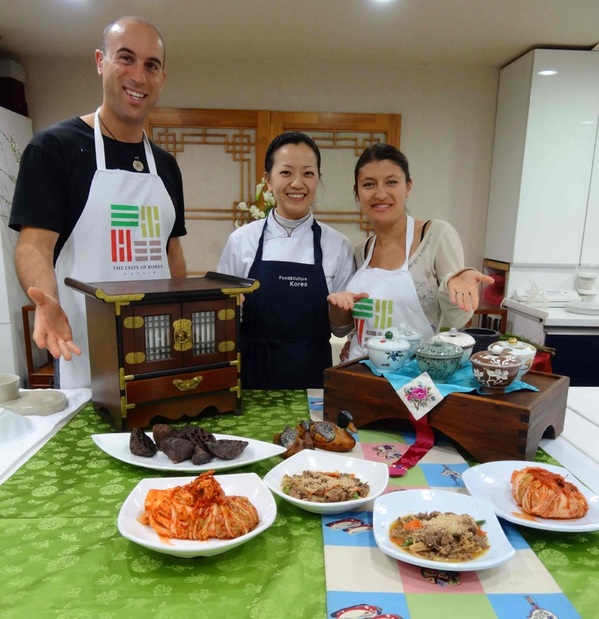
The final product - with Ellie from Food and Culture Korea Academy
The class was a lot of fun as Neda & I received one-on-one attention from Ellie and other cooks in the kitchen as they prepared a smorgasbord of Korean food for an upcoming film shoot. We learned how a specific combination of fish sauce, garlic, ginger, pear juice, seaweed broth, and red chili powder transform salted cabbage into the flavor sensation of kimchi. It was also interesting to learn that early kimchi didn’t contain the spicy flavors of today’s kimchi because the chili pepper had yet to be introduced from the New World. After prepping our kimchi and frying up our Bulgogi, we sat down to eat our creations…delicious!
Dumplings & Japche
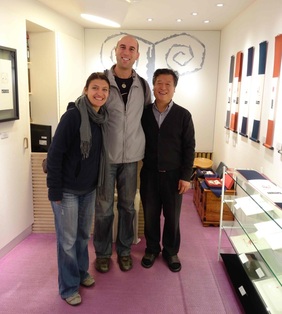
After our class we walked along the famed Insadong Street, known for its art galleries and craft stores. We found an artisan who specialized in a unique type of calligraphy in which he creates his own custom stamps from stone, which he then presses onto parchment. We were enchanted by his portrayal of the 4 Guardian Symbols that were found in Goguryeo-era tombs from about 1000 years ago. In the tombs are beautiful drawings of the Azure Dragon of the East, the White Tiger of the West, the Black Turtle of the North, and the Red Phoenix of the South. We bought parchments of the Azure Dragon and White Tiger to symbolize our adventure from West to East and back again!
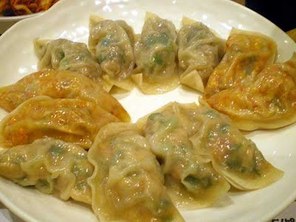
After that big cooking class, dinner was at a little hole in the wall serving a Korean classic – the dumpling (in Korean called Mandu)! We got a sampler that contained the whole variety. The classic steamed dumpling stuffed with minced meat, green onions, garlic and ginger was delicious. However, the Japchae Goon Mandu (deep-fried dumpling stuffed with sweet potato noodles and seasonings) was stellar as was the Kimchi Mandu, a dumpling stuffed with minced meat and kimchi.
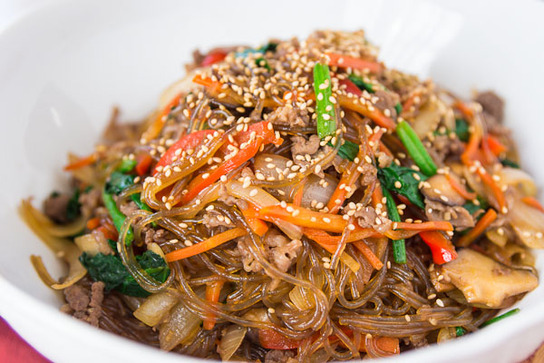
Here is Japchae - now just imagine this stuffed into a fried dumpling...mmmm!
Bibimbap
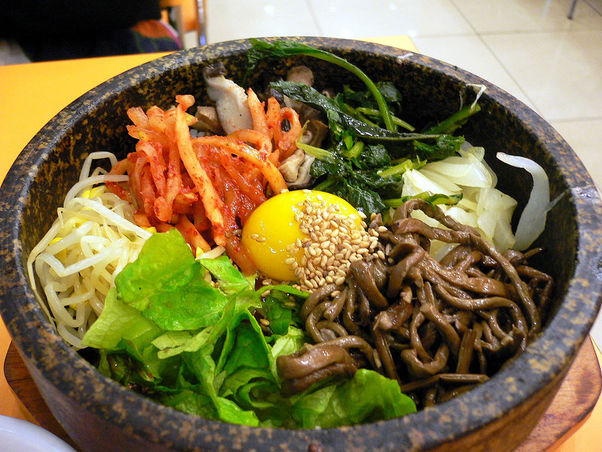
Delicious Bibimbap in a Stone Pot!
The next morning we had what may be my favorite of all the Korean dishes mentioned thus far. Our first experience with Bibimbap came not in Korea, however, but in Austin. It was there that our friend Catherine (who is half Korean) served it to us after teaching us a great Anasura-based yoga class. Literally meaning “mixed rice” bibimbap consists of a bowl of warm rice topped with sautéed and seasoned vegetables such as shitake mushrooms, spinach, carrots, and bean sprouts along with seasonings of chili pepper, soy sauce, sesame seeds, and garlic. In the middle is a raw egg that cooks as you mix it in with all the ingredients. In Seoul we found a place doing a slight variation called dolsot bibimbap, or “stone pot mixed rice”. The whole dish comes out in a hot stone bowl and the rice becomes slightly crispy as the whole thing cooks into an unbelievably delicious rice & egg mash! It’s truly “Seoul Food”!
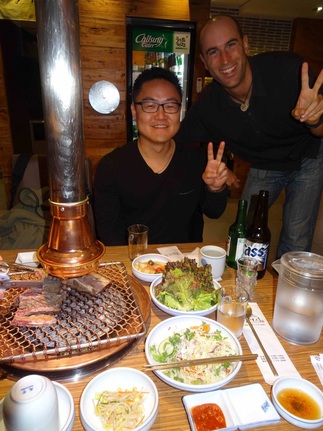 Dinner with Ricky
Dinner with Ricky It was fitting that we ate a dish that reminded us of Catherine on this day because later that afternoon we met up with her cousin Ricky, who lives in Seoul. Ricky took us to the Namsan Hanok Village, an area where traditional Korean houses have been preserved to show the architecture of the Joseon era. It was great to meet a local person and talk with him about culture in Korea and what it is like to live in a country that is constantly under threat from its belligerent neighbor to the North. At one point as we were walking down the subway stairs and discussing North Korea, Ricky told us that people in Seoul accept that death is a possibility at any time while living there. He said there is nowhere to hide if North Korea decides to launch an attack, as he well knows having served in the military like every other able-bodied male aged 18 to 35. The interesting thing is that he said it with a sort of fierce pride that implied the people of South Korea had less fear of death as a result of it being so close at hand at any given time. It called to mind our Zen teachings, which tell us that freedom from suffering can be found by being intimate with the fact of our death. It is never easy to have death seemingly loom over us all the time, but it can force a change in perspective that if done in a spiritual way, can lead to more peacefulness instead of less as might be expected
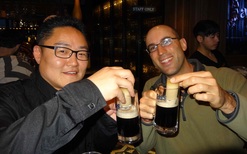 Ricky's first Irish Car Bomb
Ricky's first Irish Car Bomb Beyond just the philosophy, we had a great time eating Korean BBQ with Ricky and wandering the city with him. He took us to Itaewon, a part of the city known for its Western bars, where we sipped on high quality tequila and smoked hooka together. He also encouraged us to try Makgeolli, which is an off-white colored beverage made of fermented rice. It is a probiotic laden drink that has a pleasant acidic tang to coincide with its milky flavor. Very unique and another belly booster in Korean cuisine!
Tteokbokki
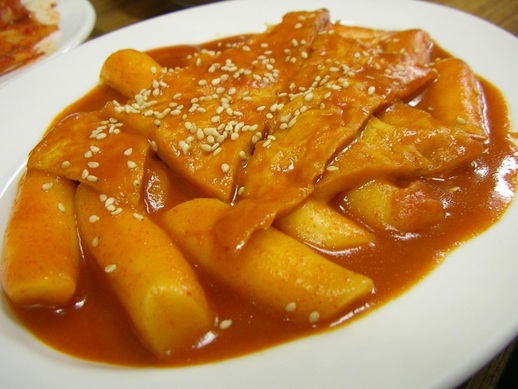
Tteokbokki
The Bibimbap was so delicious that we ate it again the next morning to give us fuel for a full day of city exploration. We started by visiting the 1,200 year old Bongeunsa Zen Temple that features beautiful old temple buildings and a
huge statue of the Maitreya Buddha. But the most striking thing about Bongeunsa was the many practioners in the main hall that were engaged in meditation or prostrations. In Japan we had never seen lay people doing these sorts of activities and it was very refreshing to see it here in Korea. We grabbed some cushions and sat in meditation with others, soaking in the pleasant atmosphere of the ancient place.
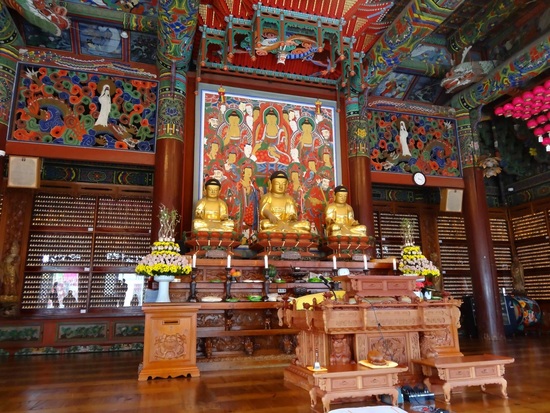
The main hall of Bongeunsa Zen Temple, where we meditated with other practioners
From there we walked down to the Seolleung Royal Tombs, which are 500 year old burial mounds that contain Kings and Queens of the Joseon Dynasty. The park provides a pleasant break from the bustle of the city and the carved statues of horses, state officials, and other animals guarding the tombs were intricately carved and well preserved despite their age.
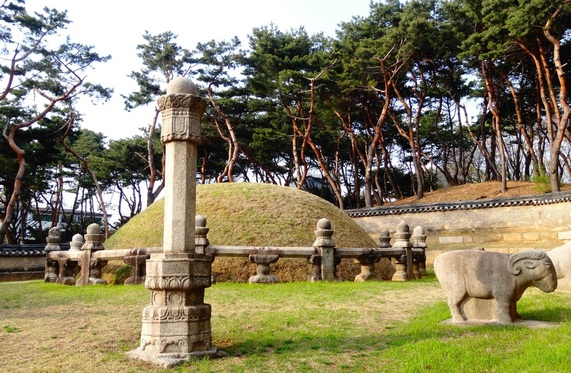
Seolleung Royal Tombs
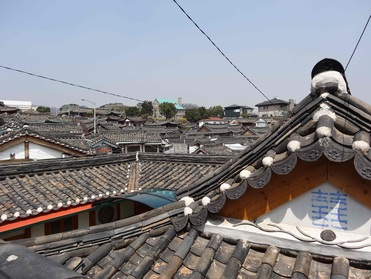 Roofs of Bukchon
Roofs of Bukchon The next day we relaxed before taking to the streets to walk the Bukchon neighborhood, which contains hundreds of old Joseon-style houses lining narrow streets that are criss-crossed with even narrower alleys. The beautiful old roofs shined under the mid-day sun and made us feel like we had traveled back in time a bit. While talking about walking the streets, I wanted to make mention of one of the most popular street foods we sampled while in Seoul – tteokbokki (see pic above). Consisting of sliced rice cakes soaked in a spicy red sauce along with minute amounts of meat, this one wasn’t a hit for me. The rice cakes are quite chewy and the sauce lacked the flavor I had come to expect from Korean cuisine.
Originally tteokbokki had much more meat, veggies, and eggs and was served topped with ginkgo nuts and walnuts. Those versions sounds great, but I’ll have to give the street version we had a solid thumbs down!
Kimbap
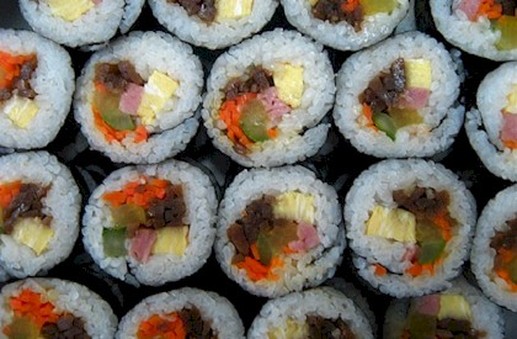
Kimbap is like sushi but stuffed with egg, carrot, marinated lotus root, ham, daikon, cucumber and sesame oil infused rice as shown here.
No need to end on a low note, however as we still haven’t reached the pinnacle of on-the-go Korean innovation – kimbap. Clearly originating from the years of the Japanese occupation, kimbap resembles a Japanese sushi roll, but has several distinct differences. Firstly, while sushi rolls in Japan tend to have only one or two ingredients inside, kimbap is more like “American sushi” being stuffed with cooked egg, daikon, cured meat & cucumber. There are other varieties, but this is the kind we saw the most, and it only cost about $1.50 for a big stuffed roll – which we saw many folks lining up for in the morning on their way to work.
Kimbap also differs from sushi because instead of using rice mixed with vinegar, it is mixed with
sesame oil, which imparts a nutty and delicious flavor to the whole roll.
We ate it often and loved it, including two rolls a piece that held us over during our long haul from Seoul to Istanbul. That’s right folks – the eastern swing is over and we are headed back to the West. A grueling 20 hour flight (with stops) awaits as we excitedly head to the cultural capital of Turkey to meet up with Neda’s parents and start the journey home. See you there!
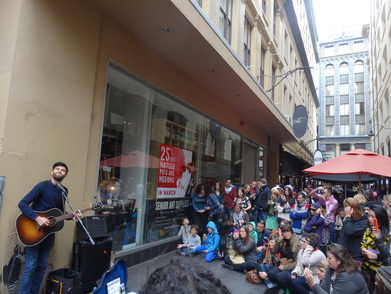 Street Performer in a Melbourne alley
Street Performer in a Melbourne alley 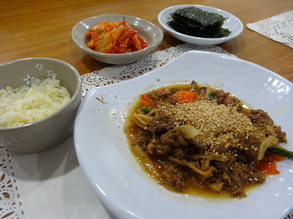 Mmmm...we miss Seoul!
Mmmm...we miss Seoul! 






















 RSS Feed
RSS Feed